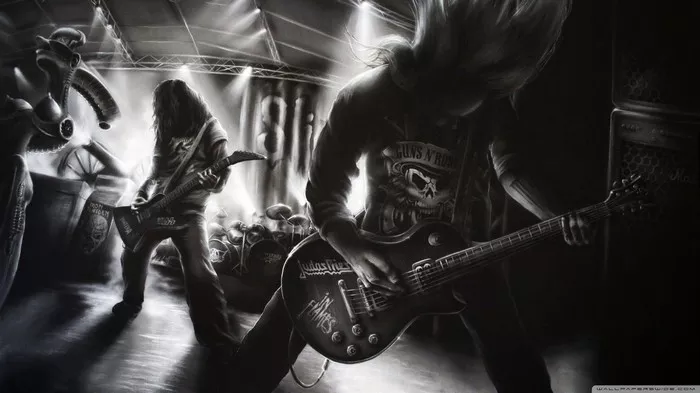Death Metal: a genre that resonates with sheer brutality, bone-chilling growls, and relentless guitar riffs. Its roots delve deep into the underground, with a lineage that can be traced back to the early days of extreme music. In this article, we embark on a journey to uncover the enigmatic beginnings of Death Metal and the visionaries who birthed this sonic monstrosity.
The Birth of a Sonic Monstrosity
To understand the genesis of Death Metal, one must explore the fertile grounds from which it sprouted. The late 1970s and early 1980s were a tumultuous time for the music industry. As the world witnessed the rise of punk, thrash metal, and new wave, a subculture of musicians in the United States was concocting a new brew of extreme music that would forever change the landscape: Death Metal.
Chuck Schuldiner: The Pioneer of Death Metal
The name Chuck Schuldiner looms large in the annals of Death Metal history. Hailing from Orlando, Florida, Schuldiner was a visionary guitarist and vocalist who played a pivotal role in shaping the genre. In 1983, he founded the band Death, which would become synonymous with the Death Metal movement. The band’s 1987 debut album, “Scream Bloody Gore,” is often hailed as one of the earliest Death Metal recordings.
Florida: The Cradle of Death Metal
Florida, a seemingly unlikely hub for extreme music, played an integral role in nurturing the Death Metal scene. Bands like Death, Morbid Angel, and Obituary emerged from the swamps of the Sunshine State, forging a distinctive sound characterized by blistering guitar work, guttural vocals, and macabre themes. Death Metal had found its home in the humid, mosquito-infested landscapes of Florida.
Bands That Shaped the Death Metal Sound
As Death Metal began to evolve, it incorporated elements from various musical genres. Bands like Possessed and Celtic Frost infused their music with the aggression and darkness that would define the genre. “Seven Churches” by Possessed, released in 1985, is often cited as a pivotal album that laid the foundation for Death Metal’s sonic characteristics.
The Transatlantic Connection: Death Metal in Europe
While Death Metal was brewing in the United States, a parallel movement was taking shape across the Atlantic in Europe. Bands like Venom, Bathory, and Hellhammer were pioneering a style that would later be recognized as Black Metal. However, Death Metal was not far behind, and Europe soon became a breeding ground for its own brand of extreme music.
Swedish Death Metal: A Distinctive Subgenre
In the late 1980s and early 1990s, Sweden emerged as a powerhouse in the Death Metal world. Bands like Entombed, Dismember, and Grave pushed the boundaries of brutality and melody. Swedish Death Metal was characterized by its signature “buzzsaw” guitar tone, a crushing wall of sound that set it apart from its American counterparts.
Death Metal Goes Global
As the 1990s dawned, Death Metal continued to spread its tendrils across the globe. Bands from countries as diverse as Finland, the Netherlands, and Brazil adopted the style and made it their own. The genre evolved, giving birth to subgenres like Melodic Death Metal (popularized by bands like In Flames and At The Gates) and Technical Death Metal (exemplified by acts like Death and Necrophagist).
The Influence of Death Metal
Death metal is a subgenre of heavy metal music known for its extreme intensity, characterized by aggressive guitar riffs, thundering drums, and guttural vocals. Since its emergence in the late 1980s, death metal has exerted a significant influence on both the music industry and popular culture.
Musically, death metal has pushed the boundaries of technicality and brutality, inspiring countless musicians to experiment with complex compositions and virtuosic instrumentations. Bands like Death, Cannibal Corpse, and Morbid Angel pioneered this style, setting the stage for the evolution of extreme metal.
Beyond its musical impact, death metal has also contributed to a vibrant subculture, with dedicated fan communities, distinctive artwork, and lyrical themes exploring topics like mortality, horror, and existentialism. The genre has even seeped into mainstream consciousness, influencing various forms of art, fashion, and film.
In essence, death metal’s profound influence extends far beyond its sonic brutality, leaving an indelible mark on the world of music and beyond.
The Legacy of Death Metal
Today, Death Metal stands as a genre with a rich history and a vibrant global community of fans. Chuck Schuldiner, often referred to as the “Godfather of Death Metal,” may have passed away in 2001, but his legacy lives on through countless bands and musicians who continue to push the boundaries of brutality and technicality.
Conclusion
In every paragraph of this exploration into the origins of Death Metal, the keyword “Death Metal” has been a constant thread. Its emergence in the underground scene, the visionary musicians who shaped it, and its global influence have been central to its evolution. Death Metal remains a formidable force in the world of music, and its legacy is a testament to the power of extreme music to challenge norms and captivate audiences with its unrelenting intensity.

